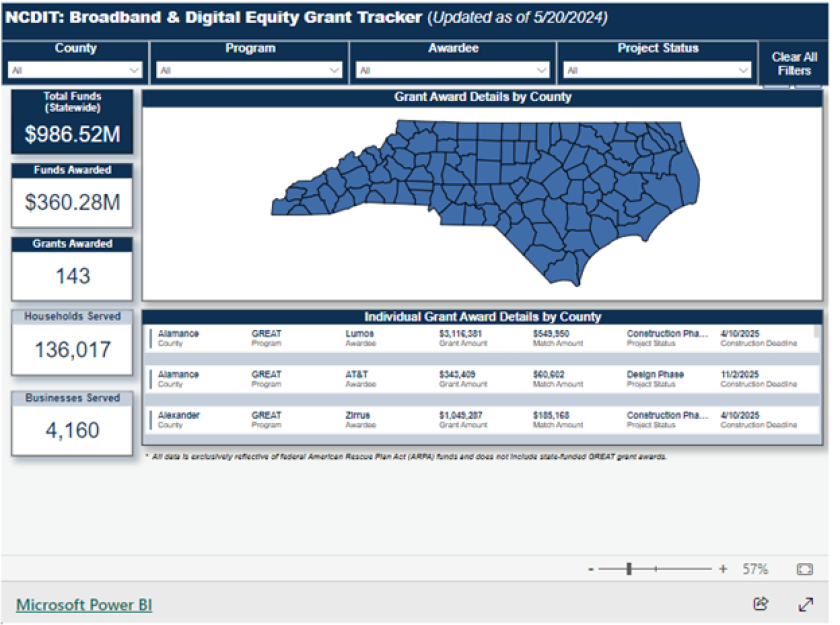- NC Announces $67M in Funding, New Dashboards
- More Initial Proposals Approved for BEAD Funding
- The ACP Is Over but Stakeholders Maintain Hope
- Census Data: Who Does the Digital Divide Impact?
- Chicago Expands Wi-Fi in Public Places
NORTH CAROLINA ANNOUNCES BROADBAND FUNDING, DASHBOARDS
The North Carolina Department of Information Technology (NCDIT) has announced the availability of $67 million in funding through the Completing Access to Broadband (CAB) program. This funding — $35 million from the American Rescue Plan Act, $16 million from counties and $16 million from broadband providers — will help connect more than 15,000 households.
Through this program, counties can partner with NCDIT to identify areas that need support and make awards to fill the gaps, provided that those awarded commit to providing high-speed service with upload and download speeds of 100 megabits per second.
As NCDIT Secretary and CIO Jim Weaver said in the announcement, partnerships between NCDIT and county leaders will help to ensure the state’s digital equity work meets community needs — and Weaver underlined previous work to conduct extensive mapping as contributing to the process’s efficiency.
The following counties will be impacted by these awards: Avery, Beaufort, Cabarrus, Chatham, Chowan, Cleveland, Haywood, Jones, Lee, McDowell, Pamlico, Pasquotank, Perquimans, Pitt and Union.
These awards build on the more than $356 million in grants through the Growing Rural Economies with Access to Technology and CAB programs. These programs provide matching grants to providers that partner with counties to compete for funding.

The dashboards — which show funds awarded by county, by program and as a broad overview — can be found on the NCDIT broadband division’s website.
“I appreciate the partnership among NCDIT, county leaders and broadband providers in helping close our state’s digital divide,” said Gov. Roy Cooper in the announcement.
MORE INITIAL PROPOSALS APPROVED FOR BEAD FUNDING
Several new states have had their initial proposals for the Broadband Equity, Access and Deployment (BEAD) Program accepted as of Thursday. Illinois, Kentucky, Maine, Oregon and Puerto Rico have had their proposals accepted. This initial proposal phase follows the recent acceptance of all 50 states’ digital equity plans, which allowed them to move forward towards plan implementation.
The acceptance of these proposals allows these entities to request access to funding: more than $1 billion for Illinois, more than $1 billion for Kentucky, more than $271 million for Maine, more than $688 million for Oregon, and more than $334 million for Puerto Rico.
Last week, Colorado and New Hampshire were the latest in a series of states to get their plans accepted. The BEAD program is a $42.45 billion state grant program that was enacted through the Bipartisan Infrastructure Law, and the National Telecommunications and Information Administration will continue to accept these proposals on a rolling basis.
THE ACP IS OVER BUT STAKEHOLDERS MAINTAIN HOPE
In the wake of the end of the Affordable Connectivity Program, which officially ended due to a lack of funding on June 1, there is still work being done to ensure access to affordable, high-speed Internet service.
For example, the Saving Americans’ Valuable Earnings on the National Affordable Connectivity Program (SAVE on ACP) Act was introduced last week. This bill aims to provide $6 billion for the program and reduce waste by adjusting the eligibility requirements. This isn’t the first bill introduced to fill the gap, as legislation that would provide funding through 2024 was introduced earlier this year. However, barring congressional action, the program’s future remains unknown.
Earlier this year, efforts began to wind down the program following the February close of enrollment. Unless and until further funding is secured, some Internet service providers, like AT&T, Comcast and Verizon, are taking steps to offer consumers an affordable service option. And stakeholders continue to push for the program. Last week, all 51 New York City Council members signed a letter to Sen. Chuck Schumer urging the renewal of program funding.
CENSUS DATA: WHO DOES THE DIGITAL DIVIDE IMPACT?
A new report from the U.S. Census Bureau relays 2021 American Community Survey data on computer and Internet use in the country.
Among other things, the report reveals that 95 percent of households surveyed had at least one type of computer, and 90 percent had a broadband Internet subscription. However, a digital divide still exists. The data suggests that lower Internet subscription rates were associated with households that rented, households with at least one person with a disability, and households with limited English proficiency.
Also notable, households that only use a smartphone to access the Internet were more likely to make $25,000 or less each year, be headed by a senior, or have a Black or Hispanic householder.
CHICAGO EXPANDS WI-FI IN PUBLIC PLACES
At the local level, Chicago is extending two programs to bring free Internet access to new areas in the city: the Chicago Park District’s Citywide Broadband and Digital Equity Initiative, and the Chicago Public Schools’ Chicago Connected program.
The first program is in the first phase of installation, having improved indoor broadband at 27 of 60 park fieldhouses, and the second phase will begin this fall to address outdoor areas. The third phase, in winter 2025, will improve existing Wi-Fi at 100 additional parks. More information about the parks impacted can be found in the announcement.
The second program was set to expire this summer, but a $4 million grant through the American Rescue Plan Act is enabling its continuation through June 2025 for those families already enrolled.









